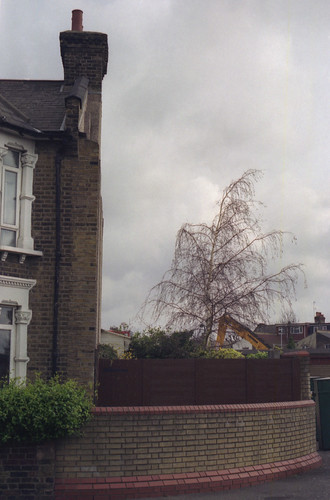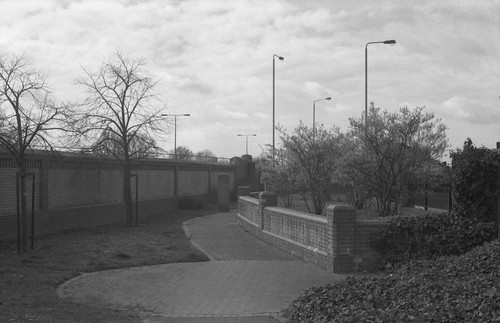 |
| Corner of Grove Green Road and Claremont Road, 2nd August 1994 |
A reason I may not have revisited this particular set of photographs in 2014 when I had done so for the others is that most of these pictures were taken on Claremont Road itself, which was almost completely wiped away by the building of the road–and there were only nine photographs from 1994. This was due to running out of film: I had been taking photographs around Wapping, Rotherhithe, and Greenwich earlier in the day, was on my second and last roll of film I had with me, and only got out at Leyton station, interrupting my journey home, in order to use the last few frames. I hadn't taken any photographs of the destruction along the route of the M11 Link Road since March that year: the camera I had been using, a Praktica BC1 (my first 35mm SLR and my first 'proper' camera) had jammed shortly after the last roll of film taken in March, and was uneconomical to fix. I didn't buy a new camera until the summer, finding a secondhand Praktica BCA body to replace the BC1 and keeping the original f1.8 50mm lens.
 |
| Grove Green Road, 2nd August 2024 |
Emerging from Leyton station that day, it was immediately clear that something was happening. Most of the photographs taken earlier that year are eerily devoid of people, partly as many were taken on Dyers Hall Road and Colville Road; the focus of the protests was Claremont Road–of which I had taken a number of photographs, but saw almost no one in all the times I was taking pictures–perhaps the protest activity only really began to make itself felt later in the year. Immediately I'd left the station I passed a number of police vans and ambulances, and then coaches with scores of police. Walking from Leyton station along Grove Green Road, the junction of the southern end of Claremont Road was blocked by police; I walked along Grove Green Road to the other end of Claremont Road, which was still open. The first photograph at the head of this post was taken at this corner, blocked with broken furniture, with a BBC news Land Rover parked alongside (there was a segment on the news on television that night, but filmed from before I arrived; I found this clip on YouTube filmed that day–about 11 minutes in–although the footage appears earlier in the afternoon). The second photograph is taken looking over where some houses had been demolished on Grove Green Road–the elevated position was taken from the Cathall Road bridge over the railway. The bridge is now wider and longer, but the picture from this August is pretty much from the same position. I did wonder if any of the trees could be the same, but I think all the trees in the photograph from 1994 are on the verge of Claremont Road which faced the Central Line (there were terraced houses on one side of Claremont Road only).
What appears to have happened earlier on the 2nd of August 1994 was the dismantling of a wooden tower on the roof of one or more houses further down Claremont Road, with protestors 'locked-on' in anticipation to frustrate or delay the planned demolitions. By the time I had arrived to take my handful of pictures, the action was essentially over, although I may just have caught the last of these protestors being removed by the cherry pickers before the houses at the end of the street could be safely demolished, although it's hard to see what is actually going on in the detail of these photographs from the distance I found myself. In 1994 I certainly could have used a longer lens, but at the time I had only the 50mm Prakticar lens from my original BC1–it would be nearly another year before I got a different focal length lens, a 28mm, buying a 80-200 zoom some time after.
The image below is as close as I got to the line of police blocking the road, notably not all in riot gear, some in shirt-sleeves on that August day, providing space behind for the cherry pickers to do their work. Although I had sympathies in that direction, it's clear I was never really going to make a photojournalist: when I realised what I had walked into, I could have dashed to the high street in Leyton and bought another roll of film from somewhere, I could have found a better vantage point to take photographs, among those on the roofs. I didn't interact with any of the protestors: the previous photographs I'd taken on earlier occasions were an aesthetic project, devoid of people, which was what the first photographs were made for, although this was rather arbitrary to fit into a theme. Simultaneously, I realised I was creating a record of sorts, if entirely unsystematic and partial. Looking back, I wished I'd taken more photographs of course, as I've previously written.
It was serendipity that I happened to have nine frames remaining on the roll of film in my camera on that day, and that I made the decision to get off the Central Line train when I did–coming back from Greenwich on the Docklands Light Railway, I had changed to the Central Line at Bank, then had alighted at Stratford as I was on an Epping train and had thought to take the train to Ilford but with several minutes for that train, I got back on the Central Line, with a Loughton destination–and this might have prompted me to get out at Leyton, the very next stop.
I had no way of knowing that something was happening that day. In my first post, I mentioned the pre-internet media ecology of the mid-1990s, with the analogue alternatives at the time, such as SchNEWS; publications such as the Big Issue were also useful for alternative voices, set apart from newspapers and the four channels of terrestrial television sources. For the immediacy of an event like the evictions on the 2nd of August, one would have to had been local to know, or be part of that particular network (I knew precisely two people with mobile phones at the time). I did not going back to take any more photographs after that day–I had another six or seven weeks to do so before I left London to start my degree. Some of the photographs from the M11 Link Road were used in some etchings in my first year of my degree; as I wrote in Retracings, these photographs were part of my formative engagement with photography, learning the craft of the darkroom, all of which would be reiterated on my degree, with a new darkroom to get used to, and the time to become more deeply immersed in photography once again.

















































